Performance Analysis: Interference Cancellation Techniques in NOMA
VerifiedAdded on 2023/06/14
|23
|3580
|214
Report
AI Summary
This paper investigates the comparative performance of interference cancellation techniques within Non-Orthogonal Multiple Access (NOMA) systems for cellular networks. It addresses the challenge of interference caused by devices within the same or adjacent cells, which degrades receiver sensitivity. The report explores how NOMA, particularly power domain multiplexing, can improve spectral efficiency and cell-edge throughput. It highlights the importance of superposition coding at transmission and successive interference cancellation (SIC) at reception. The research emphasizes that NOMA serves pairs of users with differing channel gains, where power allocation strategies are crucial for capacity enhancement, and receivers decode weaker user data before their own. Simulation using MATLAB Simulink is employed to model and test the system, focusing on coding and modulation techniques like pulse amplitude modulation (PAM) with gray labeling and turbo codes to mitigate interference and enhance overall network performance.
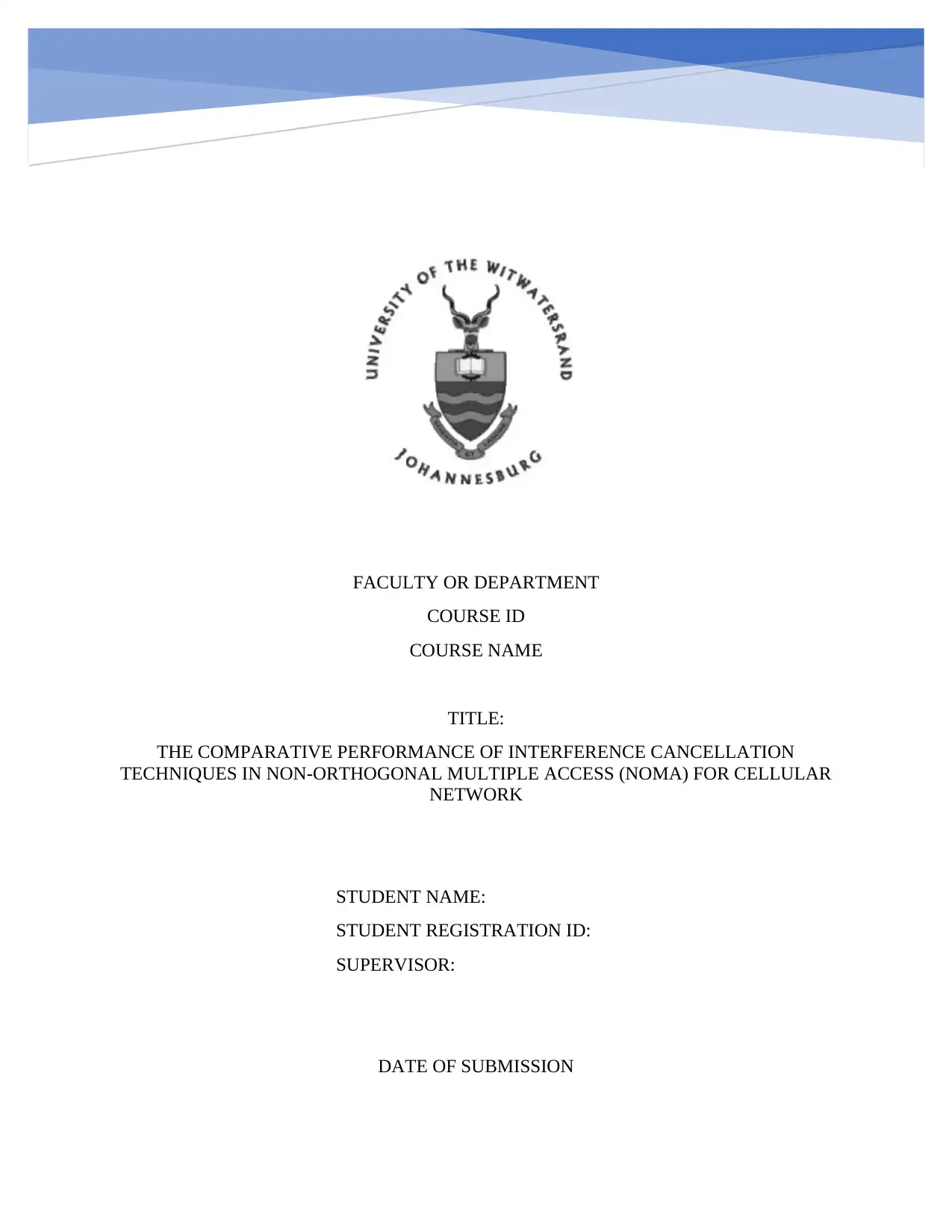
FACULTY OR DEPARTMENT
COURSE ID
COURSE NAME
TITLE:
THE COMPARATIVE PERFORMANCE OF INTERFERENCE CANCELLATION
TECHNIQUES IN NON-ORTHOGONAL MULTIPLE ACCESS (NOMA) FOR CELLULAR
NETWORK
STUDENT NAME:
STUDENT REGISTRATION ID:
SUPERVISOR:
DATE OF SUBMISSION
COURSE ID
COURSE NAME
TITLE:
THE COMPARATIVE PERFORMANCE OF INTERFERENCE CANCELLATION
TECHNIQUES IN NON-ORTHOGONAL MULTIPLE ACCESS (NOMA) FOR CELLULAR
NETWORK
STUDENT NAME:
STUDENT REGISTRATION ID:
SUPERVISOR:
DATE OF SUBMISSION
Paraphrase This Document
Need a fresh take? Get an instant paraphrase of this document with our AI Paraphraser
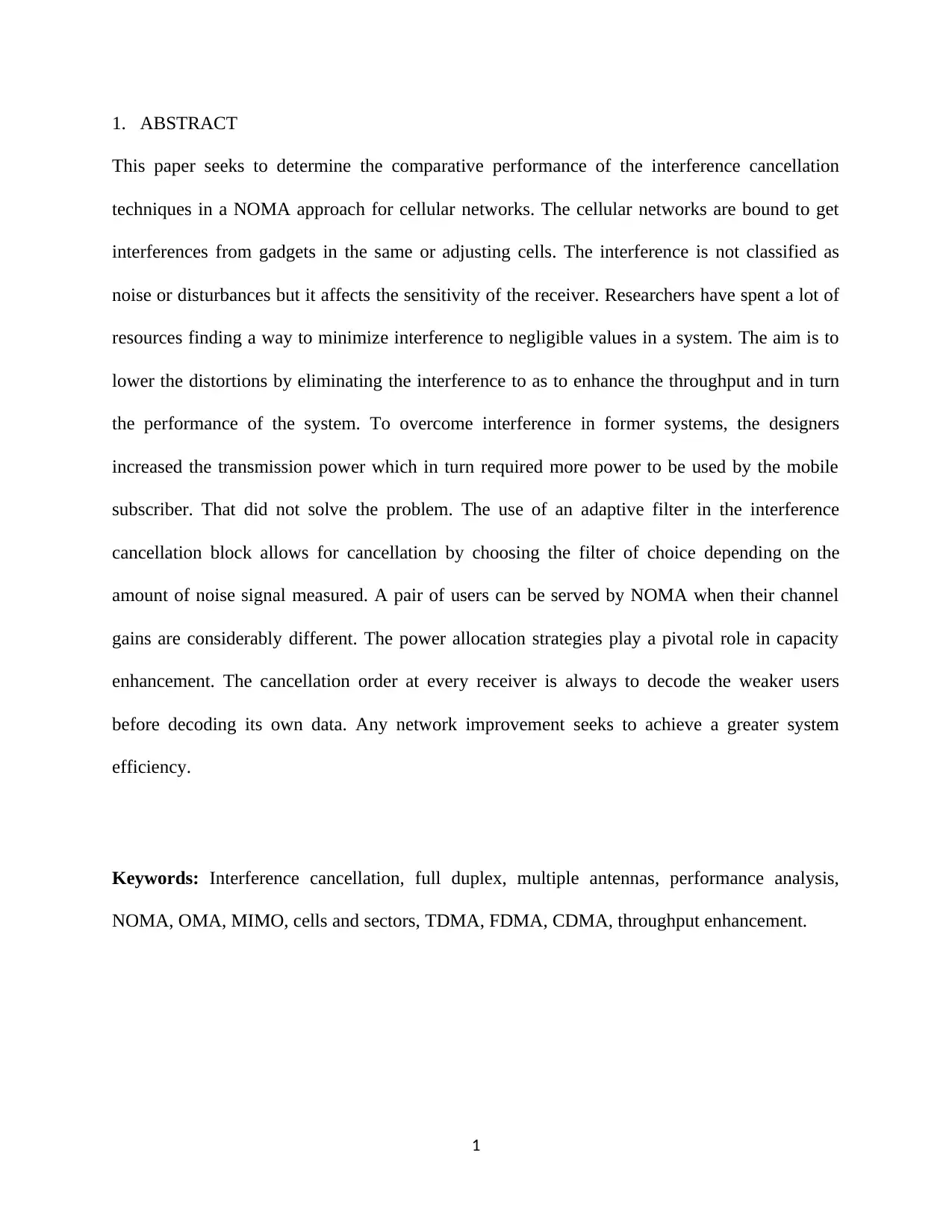
1. ABSTRACT
This paper seeks to determine the comparative performance of the interference cancellation
techniques in a NOMA approach for cellular networks. The cellular networks are bound to get
interferences from gadgets in the same or adjusting cells. The interference is not classified as
noise or disturbances but it affects the sensitivity of the receiver. Researchers have spent a lot of
resources finding a way to minimize interference to negligible values in a system. The aim is to
lower the distortions by eliminating the interference to as to enhance the throughput and in turn
the performance of the system. To overcome interference in former systems, the designers
increased the transmission power which in turn required more power to be used by the mobile
subscriber. That did not solve the problem. The use of an adaptive filter in the interference
cancellation block allows for cancellation by choosing the filter of choice depending on the
amount of noise signal measured. A pair of users can be served by NOMA when their channel
gains are considerably different. The power allocation strategies play a pivotal role in capacity
enhancement. The cancellation order at every receiver is always to decode the weaker users
before decoding its own data. Any network improvement seeks to achieve a greater system
efficiency.
Keywords: Interference cancellation, full duplex, multiple antennas, performance analysis,
NOMA, OMA, MIMO, cells and sectors, TDMA, FDMA, CDMA, throughput enhancement.
1
This paper seeks to determine the comparative performance of the interference cancellation
techniques in a NOMA approach for cellular networks. The cellular networks are bound to get
interferences from gadgets in the same or adjusting cells. The interference is not classified as
noise or disturbances but it affects the sensitivity of the receiver. Researchers have spent a lot of
resources finding a way to minimize interference to negligible values in a system. The aim is to
lower the distortions by eliminating the interference to as to enhance the throughput and in turn
the performance of the system. To overcome interference in former systems, the designers
increased the transmission power which in turn required more power to be used by the mobile
subscriber. That did not solve the problem. The use of an adaptive filter in the interference
cancellation block allows for cancellation by choosing the filter of choice depending on the
amount of noise signal measured. A pair of users can be served by NOMA when their channel
gains are considerably different. The power allocation strategies play a pivotal role in capacity
enhancement. The cancellation order at every receiver is always to decode the weaker users
before decoding its own data. Any network improvement seeks to achieve a greater system
efficiency.
Keywords: Interference cancellation, full duplex, multiple antennas, performance analysis,
NOMA, OMA, MIMO, cells and sectors, TDMA, FDMA, CDMA, throughput enhancement.
1
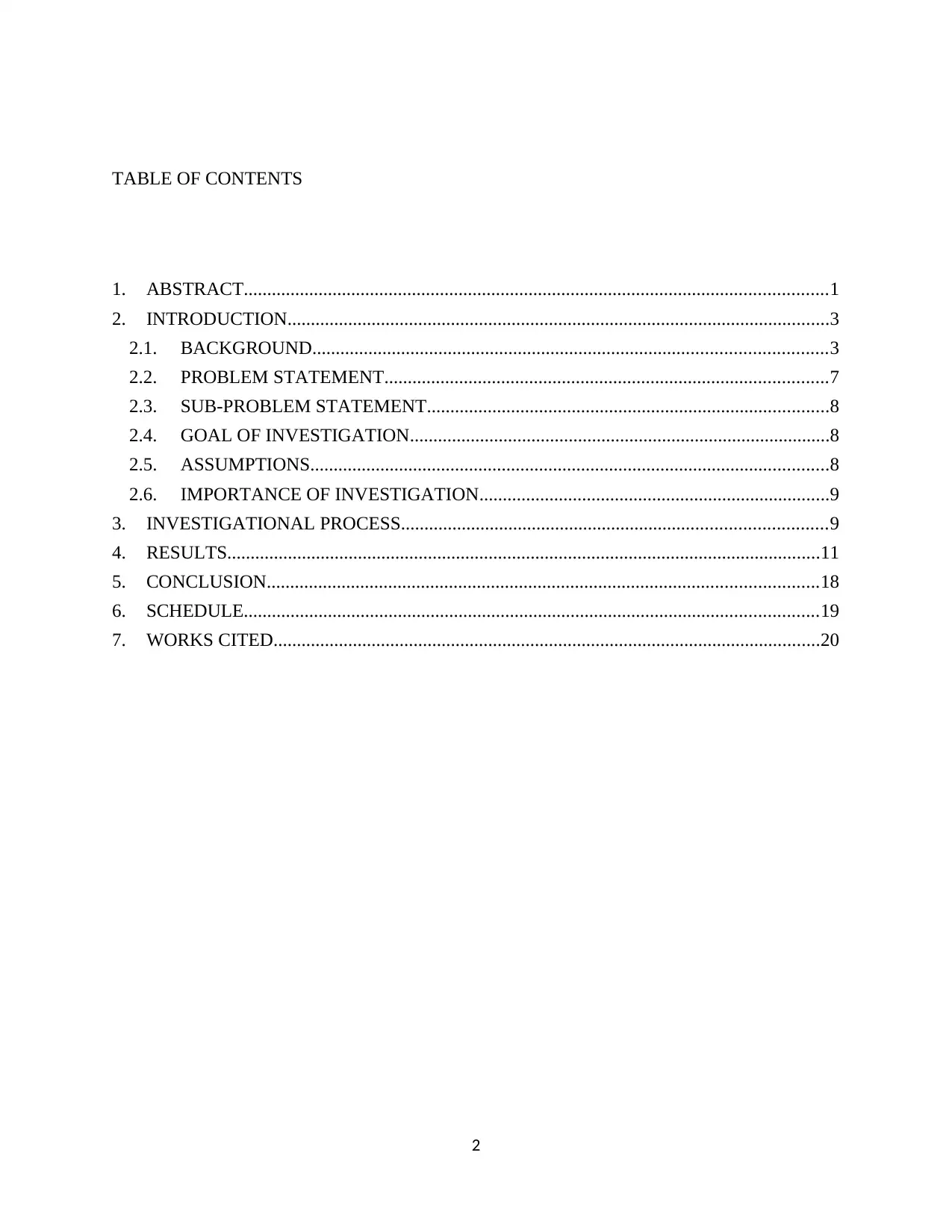
TABLE OF CONTENTS
1. ABSTRACT.............................................................................................................................1
2. INTRODUCTION....................................................................................................................3
2.1. BACKGROUND..............................................................................................................3
2.2. PROBLEM STATEMENT...............................................................................................7
2.3. SUB-PROBLEM STATEMENT......................................................................................8
2.4. GOAL OF INVESTIGATION..........................................................................................8
2.5. ASSUMPTIONS...............................................................................................................8
2.6. IMPORTANCE OF INVESTIGATION...........................................................................9
3. INVESTIGATIONAL PROCESS...........................................................................................9
4. RESULTS...............................................................................................................................11
5. CONCLUSION......................................................................................................................18
6. SCHEDULE...........................................................................................................................19
7. WORKS CITED.....................................................................................................................20
2
1. ABSTRACT.............................................................................................................................1
2. INTRODUCTION....................................................................................................................3
2.1. BACKGROUND..............................................................................................................3
2.2. PROBLEM STATEMENT...............................................................................................7
2.3. SUB-PROBLEM STATEMENT......................................................................................8
2.4. GOAL OF INVESTIGATION..........................................................................................8
2.5. ASSUMPTIONS...............................................................................................................8
2.6. IMPORTANCE OF INVESTIGATION...........................................................................9
3. INVESTIGATIONAL PROCESS...........................................................................................9
4. RESULTS...............................................................................................................................11
5. CONCLUSION......................................................................................................................18
6. SCHEDULE...........................................................................................................................19
7. WORKS CITED.....................................................................................................................20
2
⊘ This is a preview!⊘
Do you want full access?
Subscribe today to unlock all pages.

Trusted by 1+ million students worldwide
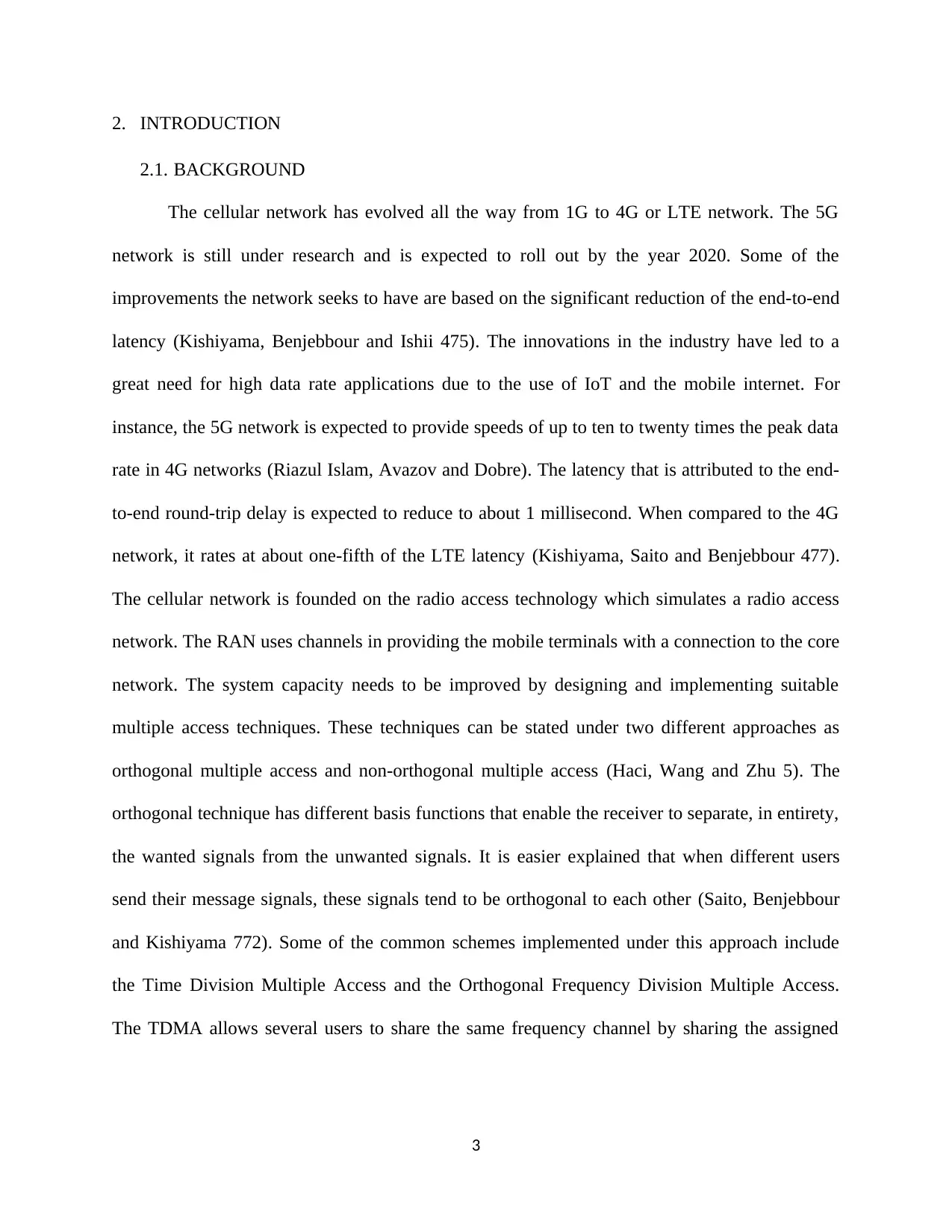
2. INTRODUCTION
2.1. BACKGROUND
The cellular network has evolved all the way from 1G to 4G or LTE network. The 5G
network is still under research and is expected to roll out by the year 2020. Some of the
improvements the network seeks to have are based on the significant reduction of the end-to-end
latency (Kishiyama, Benjebbour and Ishii 475). The innovations in the industry have led to a
great need for high data rate applications due to the use of IoT and the mobile internet. For
instance, the 5G network is expected to provide speeds of up to ten to twenty times the peak data
rate in 4G networks (Riazul Islam, Avazov and Dobre). The latency that is attributed to the end-
to-end round-trip delay is expected to reduce to about 1 millisecond. When compared to the 4G
network, it rates at about one-fifth of the LTE latency (Kishiyama, Saito and Benjebbour 477).
The cellular network is founded on the radio access technology which simulates a radio access
network. The RAN uses channels in providing the mobile terminals with a connection to the core
network. The system capacity needs to be improved by designing and implementing suitable
multiple access techniques. These techniques can be stated under two different approaches as
orthogonal multiple access and non-orthogonal multiple access (Haci, Wang and Zhu 5). The
orthogonal technique has different basis functions that enable the receiver to separate, in entirety,
the wanted signals from the unwanted signals. It is easier explained that when different users
send their message signals, these signals tend to be orthogonal to each other (Saito, Benjebbour
and Kishiyama 772). Some of the common schemes implemented under this approach include
the Time Division Multiple Access and the Orthogonal Frequency Division Multiple Access.
The TDMA allows several users to share the same frequency channel by sharing the assigned
3
2.1. BACKGROUND
The cellular network has evolved all the way from 1G to 4G or LTE network. The 5G
network is still under research and is expected to roll out by the year 2020. Some of the
improvements the network seeks to have are based on the significant reduction of the end-to-end
latency (Kishiyama, Benjebbour and Ishii 475). The innovations in the industry have led to a
great need for high data rate applications due to the use of IoT and the mobile internet. For
instance, the 5G network is expected to provide speeds of up to ten to twenty times the peak data
rate in 4G networks (Riazul Islam, Avazov and Dobre). The latency that is attributed to the end-
to-end round-trip delay is expected to reduce to about 1 millisecond. When compared to the 4G
network, it rates at about one-fifth of the LTE latency (Kishiyama, Saito and Benjebbour 477).
The cellular network is founded on the radio access technology which simulates a radio access
network. The RAN uses channels in providing the mobile terminals with a connection to the core
network. The system capacity needs to be improved by designing and implementing suitable
multiple access techniques. These techniques can be stated under two different approaches as
orthogonal multiple access and non-orthogonal multiple access (Haci, Wang and Zhu 5). The
orthogonal technique has different basis functions that enable the receiver to separate, in entirety,
the wanted signals from the unwanted signals. It is easier explained that when different users
send their message signals, these signals tend to be orthogonal to each other (Saito, Benjebbour
and Kishiyama 772). Some of the common schemes implemented under this approach include
the Time Division Multiple Access and the Orthogonal Frequency Division Multiple Access.
The TDMA allows several users to share the same frequency channel by sharing the assigned
3
Paraphrase This Document
Need a fresh take? Get an instant paraphrase of this document with our AI Paraphraser
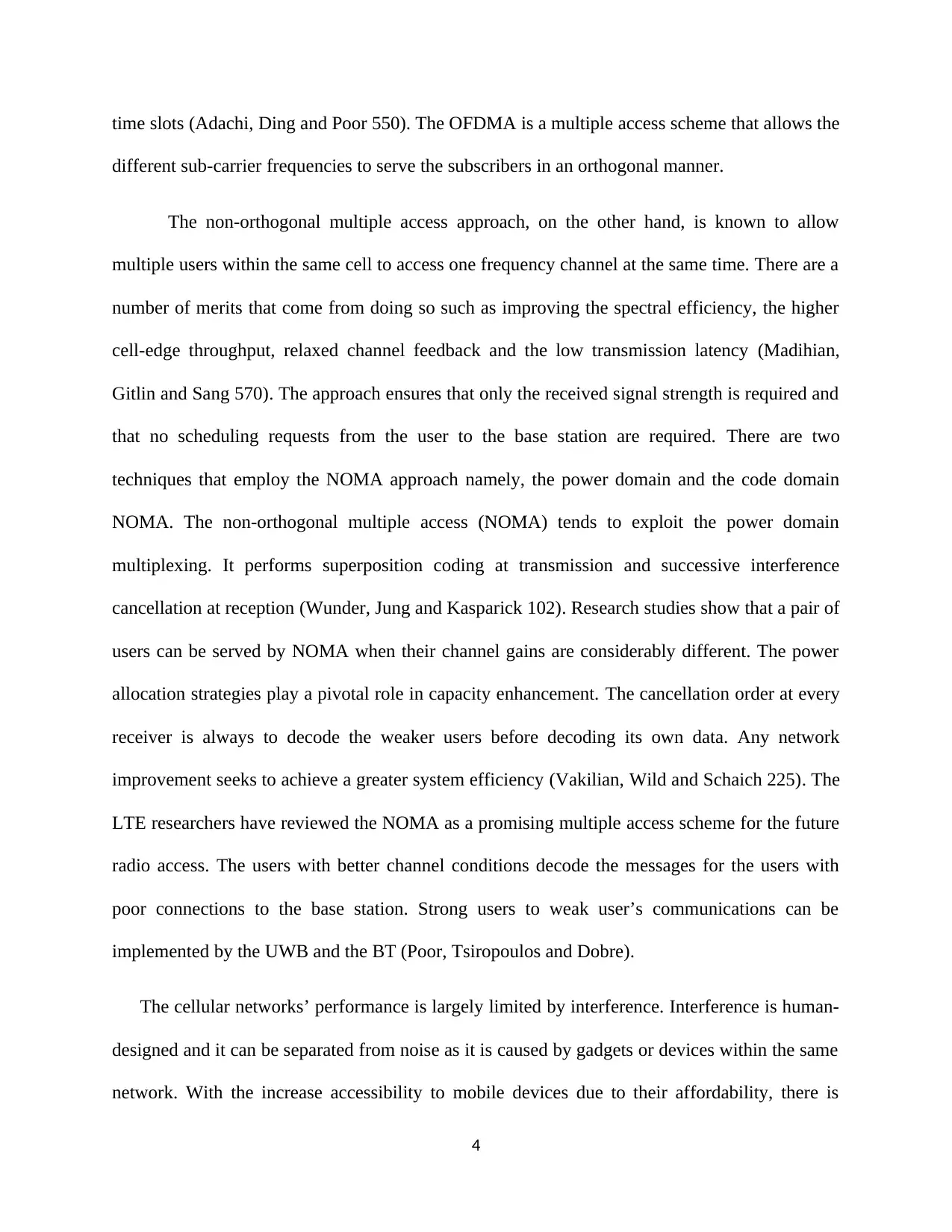
time slots (Adachi, Ding and Poor 550). The OFDMA is a multiple access scheme that allows the
different sub-carrier frequencies to serve the subscribers in an orthogonal manner.
The non-orthogonal multiple access approach, on the other hand, is known to allow
multiple users within the same cell to access one frequency channel at the same time. There are a
number of merits that come from doing so such as improving the spectral efficiency, the higher
cell-edge throughput, relaxed channel feedback and the low transmission latency (Madihian,
Gitlin and Sang 570). The approach ensures that only the received signal strength is required and
that no scheduling requests from the user to the base station are required. There are two
techniques that employ the NOMA approach namely, the power domain and the code domain
NOMA. The non-orthogonal multiple access (NOMA) tends to exploit the power domain
multiplexing. It performs superposition coding at transmission and successive interference
cancellation at reception (Wunder, Jung and Kasparick 102). Research studies show that a pair of
users can be served by NOMA when their channel gains are considerably different. The power
allocation strategies play a pivotal role in capacity enhancement. The cancellation order at every
receiver is always to decode the weaker users before decoding its own data. Any network
improvement seeks to achieve a greater system efficiency (Vakilian, Wild and Schaich 225). The
LTE researchers have reviewed the NOMA as a promising multiple access scheme for the future
radio access. The users with better channel conditions decode the messages for the users with
poor connections to the base station. Strong users to weak user’s communications can be
implemented by the UWB and the BT (Poor, Tsiropoulos and Dobre).
The cellular networks’ performance is largely limited by interference. Interference is human-
designed and it can be separated from noise as it is caused by gadgets or devices within the same
network. With the increase accessibility to mobile devices due to their affordability, there is
4
different sub-carrier frequencies to serve the subscribers in an orthogonal manner.
The non-orthogonal multiple access approach, on the other hand, is known to allow
multiple users within the same cell to access one frequency channel at the same time. There are a
number of merits that come from doing so such as improving the spectral efficiency, the higher
cell-edge throughput, relaxed channel feedback and the low transmission latency (Madihian,
Gitlin and Sang 570). The approach ensures that only the received signal strength is required and
that no scheduling requests from the user to the base station are required. There are two
techniques that employ the NOMA approach namely, the power domain and the code domain
NOMA. The non-orthogonal multiple access (NOMA) tends to exploit the power domain
multiplexing. It performs superposition coding at transmission and successive interference
cancellation at reception (Wunder, Jung and Kasparick 102). Research studies show that a pair of
users can be served by NOMA when their channel gains are considerably different. The power
allocation strategies play a pivotal role in capacity enhancement. The cancellation order at every
receiver is always to decode the weaker users before decoding its own data. Any network
improvement seeks to achieve a greater system efficiency (Vakilian, Wild and Schaich 225). The
LTE researchers have reviewed the NOMA as a promising multiple access scheme for the future
radio access. The users with better channel conditions decode the messages for the users with
poor connections to the base station. Strong users to weak user’s communications can be
implemented by the UWB and the BT (Poor, Tsiropoulos and Dobre).
The cellular networks’ performance is largely limited by interference. Interference is human-
designed and it can be separated from noise as it is caused by gadgets or devices within the same
network. With the increase accessibility to mobile devices due to their affordability, there is
4
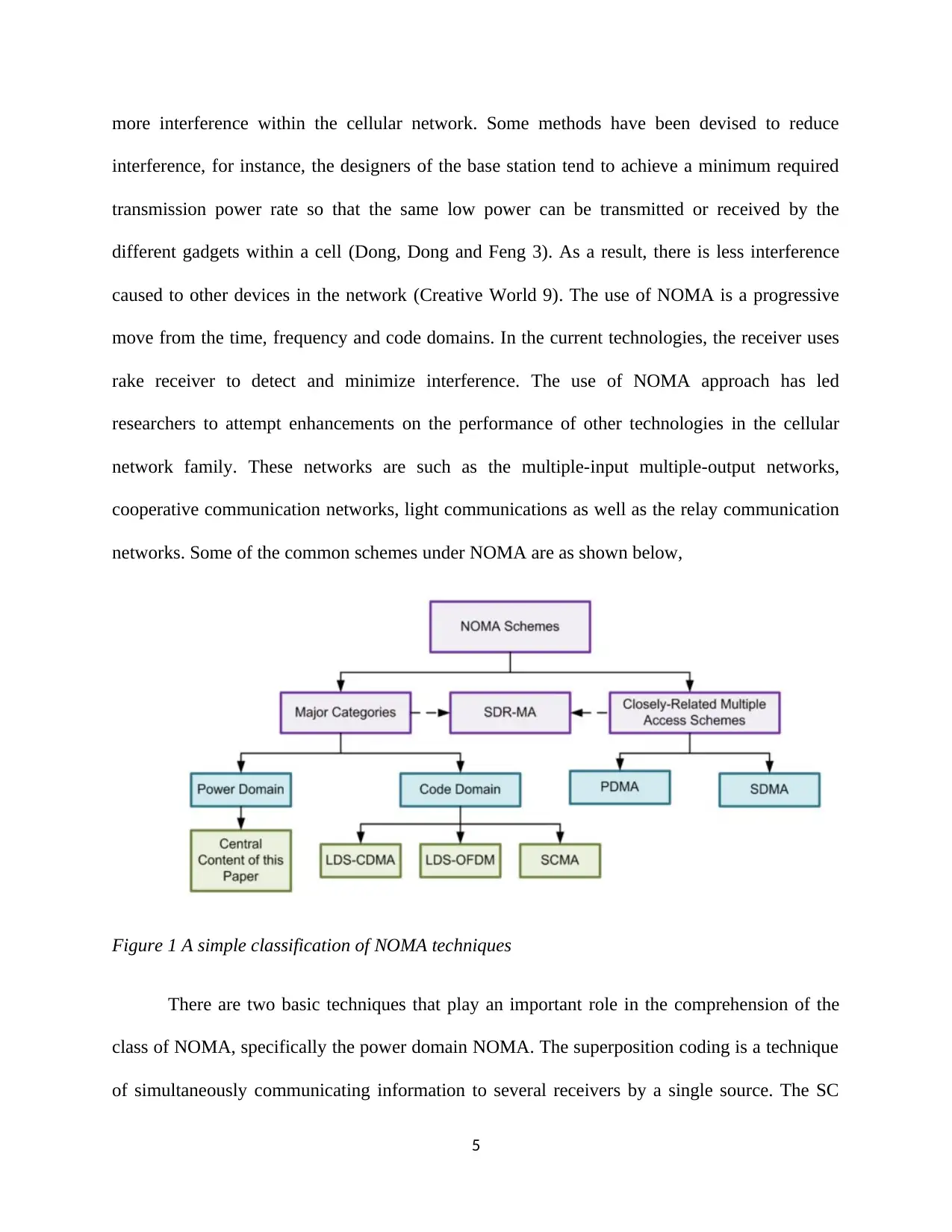
more interference within the cellular network. Some methods have been devised to reduce
interference, for instance, the designers of the base station tend to achieve a minimum required
transmission power rate so that the same low power can be transmitted or received by the
different gadgets within a cell (Dong, Dong and Feng 3). As a result, there is less interference
caused to other devices in the network (Creative World 9). The use of NOMA is a progressive
move from the time, frequency and code domains. In the current technologies, the receiver uses
rake receiver to detect and minimize interference. The use of NOMA approach has led
researchers to attempt enhancements on the performance of other technologies in the cellular
network family. These networks are such as the multiple-input multiple-output networks,
cooperative communication networks, light communications as well as the relay communication
networks. Some of the common schemes under NOMA are as shown below,
Figure 1 A simple classification of NOMA techniques
There are two basic techniques that play an important role in the comprehension of the
class of NOMA, specifically the power domain NOMA. The superposition coding is a technique
of simultaneously communicating information to several receivers by a single source. The SC
5
interference, for instance, the designers of the base station tend to achieve a minimum required
transmission power rate so that the same low power can be transmitted or received by the
different gadgets within a cell (Dong, Dong and Feng 3). As a result, there is less interference
caused to other devices in the network (Creative World 9). The use of NOMA is a progressive
move from the time, frequency and code domains. In the current technologies, the receiver uses
rake receiver to detect and minimize interference. The use of NOMA approach has led
researchers to attempt enhancements on the performance of other technologies in the cellular
network family. These networks are such as the multiple-input multiple-output networks,
cooperative communication networks, light communications as well as the relay communication
networks. Some of the common schemes under NOMA are as shown below,
Figure 1 A simple classification of NOMA techniques
There are two basic techniques that play an important role in the comprehension of the
class of NOMA, specifically the power domain NOMA. The superposition coding is a technique
of simultaneously communicating information to several receivers by a single source. The SC
5
⊘ This is a preview!⊘
Do you want full access?
Subscribe today to unlock all pages.

Trusted by 1+ million students worldwide
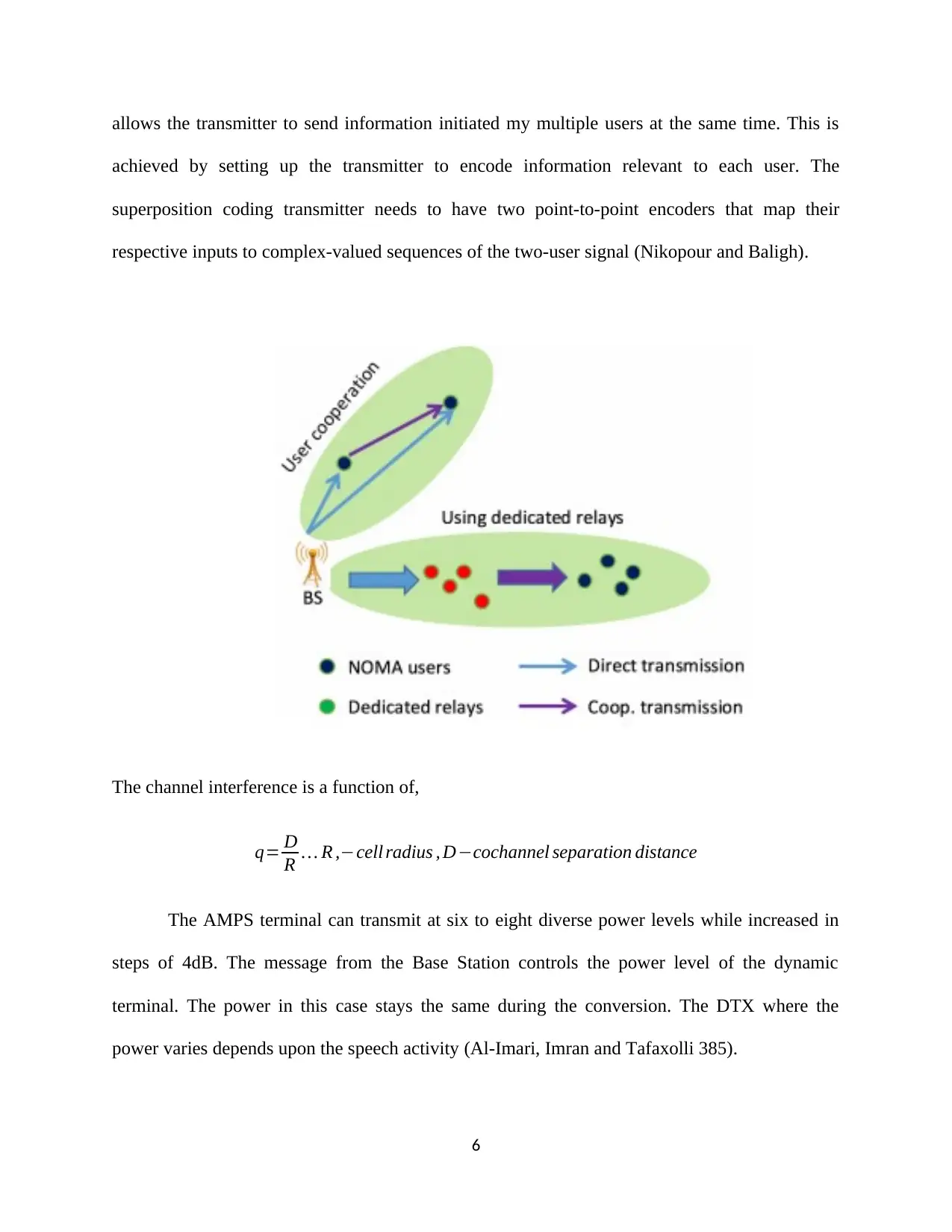
allows the transmitter to send information initiated my multiple users at the same time. This is
achieved by setting up the transmitter to encode information relevant to each user. The
superposition coding transmitter needs to have two point-to-point encoders that map their
respective inputs to complex-valued sequences of the two-user signal (Nikopour and Baligh).
The channel interference is a function of,
q= D
R … R ,−cell radius , D−cochannel separation distance
The AMPS terminal can transmit at six to eight diverse power levels while increased in
steps of 4dB. The message from the Base Station controls the power level of the dynamic
terminal. The power in this case stays the same during the conversion. The DTX where the
power varies depends upon the speech activity (Al-Imari, Imran and Tafaxolli 385).
6
achieved by setting up the transmitter to encode information relevant to each user. The
superposition coding transmitter needs to have two point-to-point encoders that map their
respective inputs to complex-valued sequences of the two-user signal (Nikopour and Baligh).
The channel interference is a function of,
q= D
R … R ,−cell radius , D−cochannel separation distance
The AMPS terminal can transmit at six to eight diverse power levels while increased in
steps of 4dB. The message from the Base Station controls the power level of the dynamic
terminal. The power in this case stays the same during the conversion. The DTX where the
power varies depends upon the speech activity (Al-Imari, Imran and Tafaxolli 385).
6
Paraphrase This Document
Need a fresh take? Get an instant paraphrase of this document with our AI Paraphraser
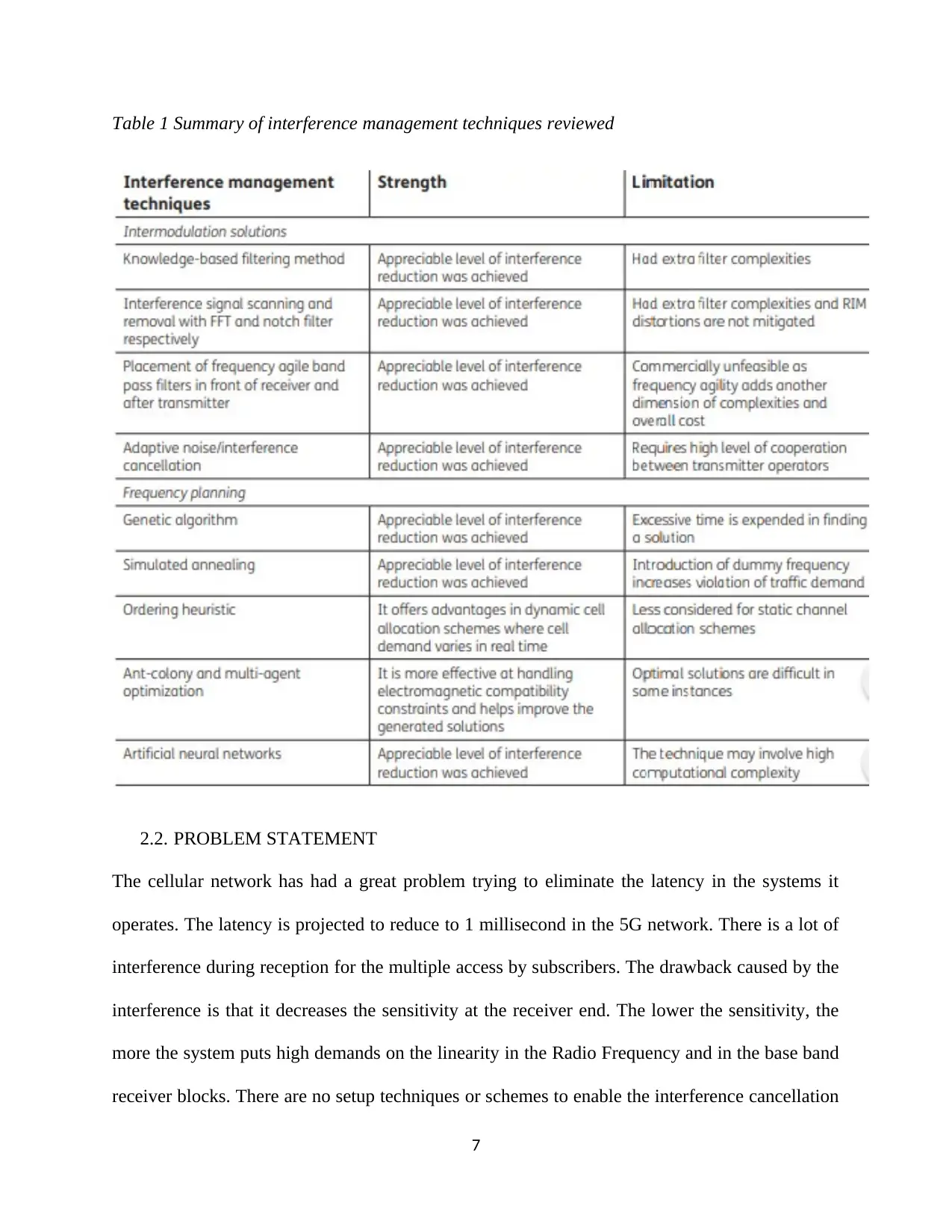
Table 1 Summary of interference management techniques reviewed
2.2. PROBLEM STATEMENT
The cellular network has had a great problem trying to eliminate the latency in the systems it
operates. The latency is projected to reduce to 1 millisecond in the 5G network. There is a lot of
interference during reception for the multiple access by subscribers. The drawback caused by the
interference is that it decreases the sensitivity at the receiver end. The lower the sensitivity, the
more the system puts high demands on the linearity in the Radio Frequency and in the base band
receiver blocks. There are no setup techniques or schemes to enable the interference cancellation
7
2.2. PROBLEM STATEMENT
The cellular network has had a great problem trying to eliminate the latency in the systems it
operates. The latency is projected to reduce to 1 millisecond in the 5G network. There is a lot of
interference during reception for the multiple access by subscribers. The drawback caused by the
interference is that it decreases the sensitivity at the receiver end. The lower the sensitivity, the
more the system puts high demands on the linearity in the Radio Frequency and in the base band
receiver blocks. There are no setup techniques or schemes to enable the interference cancellation
7
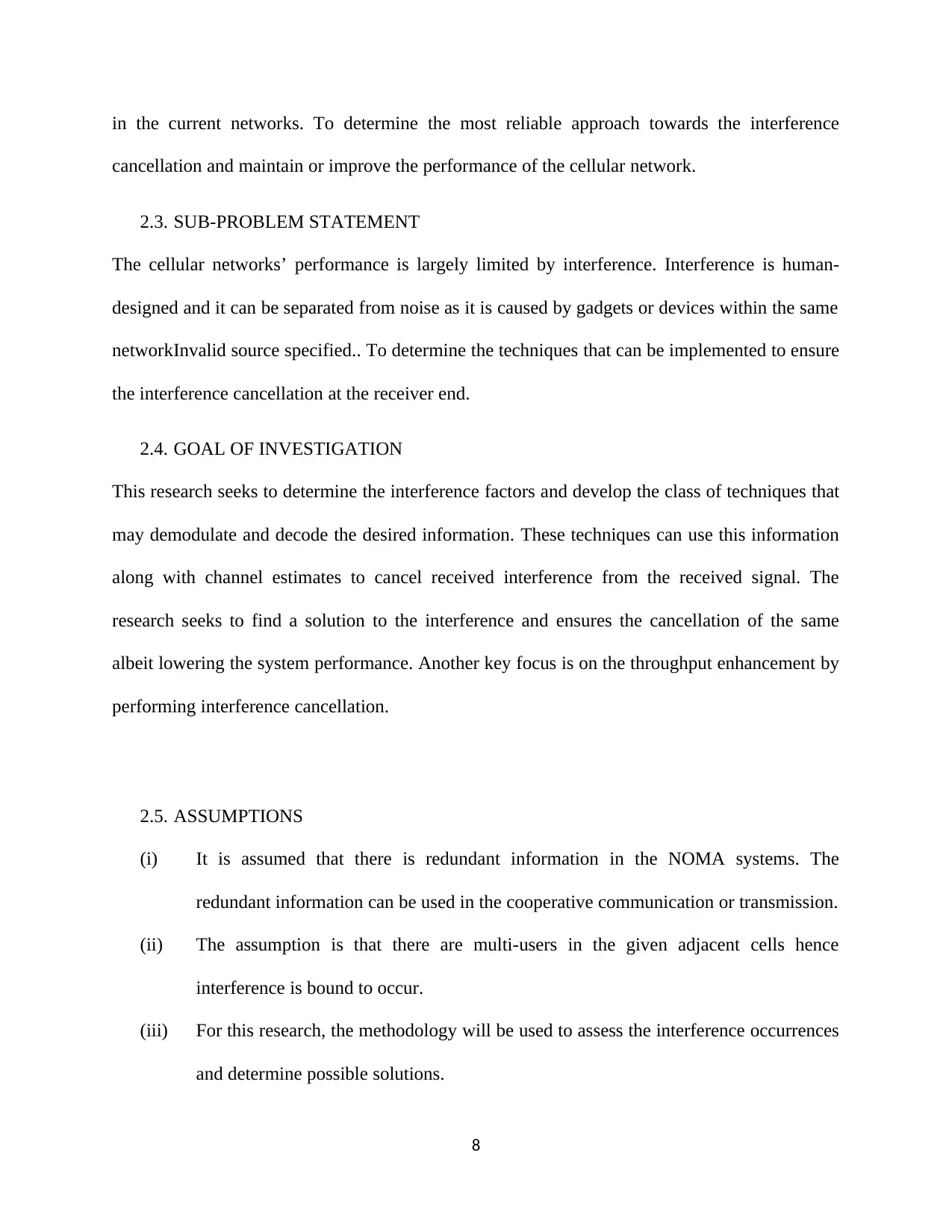
in the current networks. To determine the most reliable approach towards the interference
cancellation and maintain or improve the performance of the cellular network.
2.3. SUB-PROBLEM STATEMENT
The cellular networks’ performance is largely limited by interference. Interference is human-
designed and it can be separated from noise as it is caused by gadgets or devices within the same
networkInvalid source specified.. To determine the techniques that can be implemented to ensure
the interference cancellation at the receiver end.
2.4. GOAL OF INVESTIGATION
This research seeks to determine the interference factors and develop the class of techniques that
may demodulate and decode the desired information. These techniques can use this information
along with channel estimates to cancel received interference from the received signal. The
research seeks to find a solution to the interference and ensures the cancellation of the same
albeit lowering the system performance. Another key focus is on the throughput enhancement by
performing interference cancellation.
2.5. ASSUMPTIONS
(i) It is assumed that there is redundant information in the NOMA systems. The
redundant information can be used in the cooperative communication or transmission.
(ii) The assumption is that there are multi-users in the given adjacent cells hence
interference is bound to occur.
(iii) For this research, the methodology will be used to assess the interference occurrences
and determine possible solutions.
8
cancellation and maintain or improve the performance of the cellular network.
2.3. SUB-PROBLEM STATEMENT
The cellular networks’ performance is largely limited by interference. Interference is human-
designed and it can be separated from noise as it is caused by gadgets or devices within the same
networkInvalid source specified.. To determine the techniques that can be implemented to ensure
the interference cancellation at the receiver end.
2.4. GOAL OF INVESTIGATION
This research seeks to determine the interference factors and develop the class of techniques that
may demodulate and decode the desired information. These techniques can use this information
along with channel estimates to cancel received interference from the received signal. The
research seeks to find a solution to the interference and ensures the cancellation of the same
albeit lowering the system performance. Another key focus is on the throughput enhancement by
performing interference cancellation.
2.5. ASSUMPTIONS
(i) It is assumed that there is redundant information in the NOMA systems. The
redundant information can be used in the cooperative communication or transmission.
(ii) The assumption is that there are multi-users in the given adjacent cells hence
interference is bound to occur.
(iii) For this research, the methodology will be used to assess the interference occurrences
and determine possible solutions.
8
⊘ This is a preview!⊘
Do you want full access?
Subscribe today to unlock all pages.

Trusted by 1+ million students worldwide
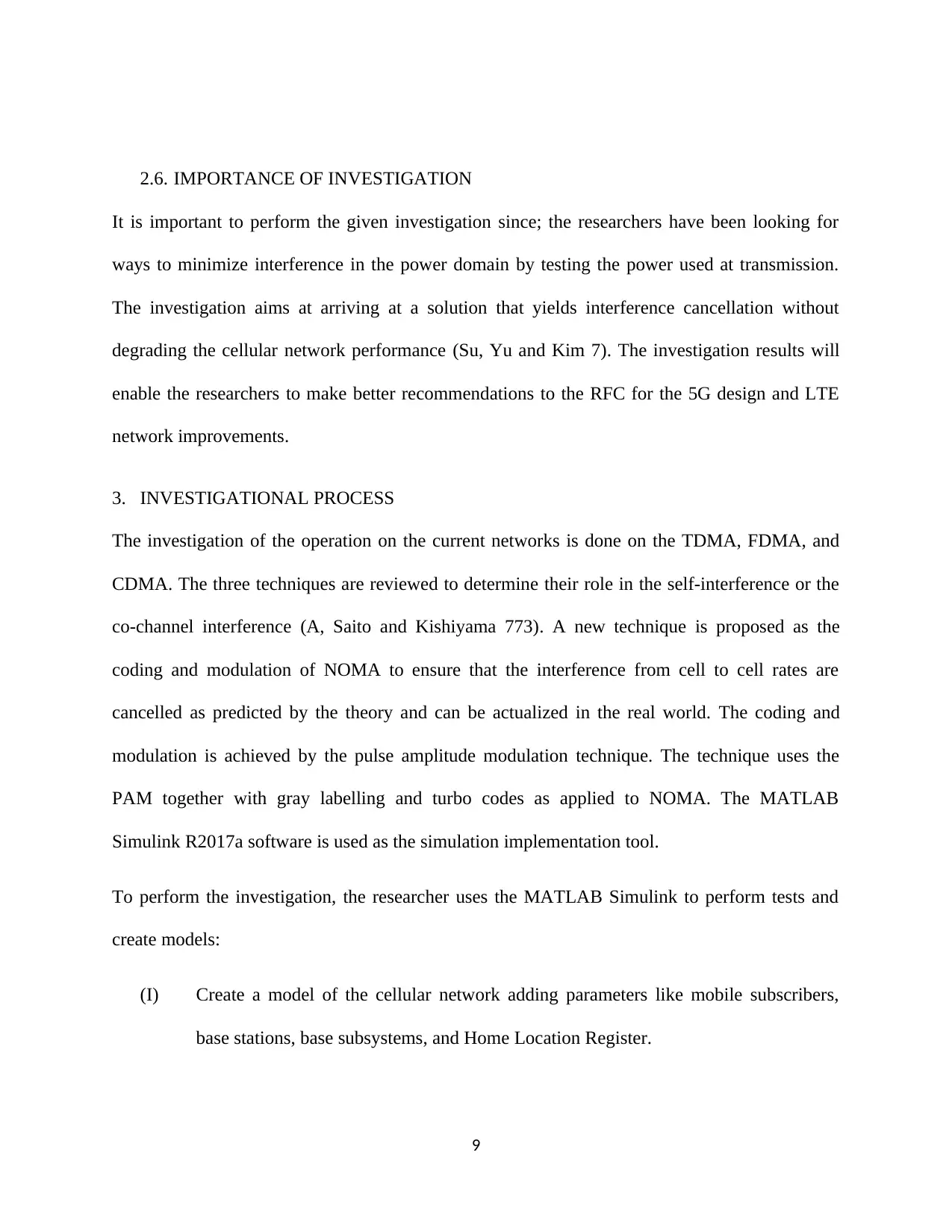
2.6. IMPORTANCE OF INVESTIGATION
It is important to perform the given investigation since; the researchers have been looking for
ways to minimize interference in the power domain by testing the power used at transmission.
The investigation aims at arriving at a solution that yields interference cancellation without
degrading the cellular network performance (Su, Yu and Kim 7). The investigation results will
enable the researchers to make better recommendations to the RFC for the 5G design and LTE
network improvements.
3. INVESTIGATIONAL PROCESS
The investigation of the operation on the current networks is done on the TDMA, FDMA, and
CDMA. The three techniques are reviewed to determine their role in the self-interference or the
co-channel interference (A, Saito and Kishiyama 773). A new technique is proposed as the
coding and modulation of NOMA to ensure that the interference from cell to cell rates are
cancelled as predicted by the theory and can be actualized in the real world. The coding and
modulation is achieved by the pulse amplitude modulation technique. The technique uses the
PAM together with gray labelling and turbo codes as applied to NOMA. The MATLAB
Simulink R2017a software is used as the simulation implementation tool.
To perform the investigation, the researcher uses the MATLAB Simulink to perform tests and
create models:
(I) Create a model of the cellular network adding parameters like mobile subscribers,
base stations, base subsystems, and Home Location Register.
9
It is important to perform the given investigation since; the researchers have been looking for
ways to minimize interference in the power domain by testing the power used at transmission.
The investigation aims at arriving at a solution that yields interference cancellation without
degrading the cellular network performance (Su, Yu and Kim 7). The investigation results will
enable the researchers to make better recommendations to the RFC for the 5G design and LTE
network improvements.
3. INVESTIGATIONAL PROCESS
The investigation of the operation on the current networks is done on the TDMA, FDMA, and
CDMA. The three techniques are reviewed to determine their role in the self-interference or the
co-channel interference (A, Saito and Kishiyama 773). A new technique is proposed as the
coding and modulation of NOMA to ensure that the interference from cell to cell rates are
cancelled as predicted by the theory and can be actualized in the real world. The coding and
modulation is achieved by the pulse amplitude modulation technique. The technique uses the
PAM together with gray labelling and turbo codes as applied to NOMA. The MATLAB
Simulink R2017a software is used as the simulation implementation tool.
To perform the investigation, the researcher uses the MATLAB Simulink to perform tests and
create models:
(I) Create a model of the cellular network adding parameters like mobile subscribers,
base stations, base subsystems, and Home Location Register.
9
Paraphrase This Document
Need a fresh take? Get an instant paraphrase of this document with our AI Paraphraser
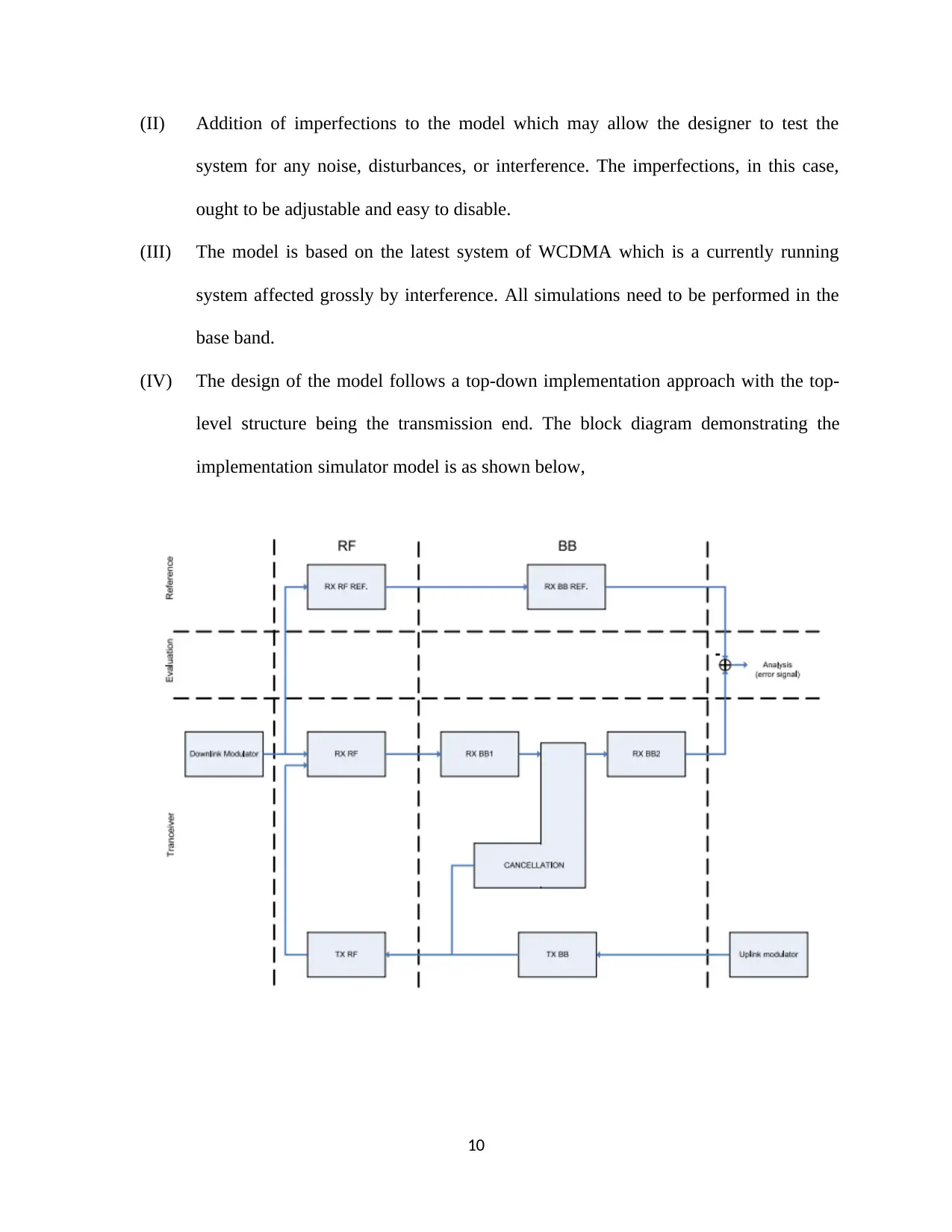
(II) Addition of imperfections to the model which may allow the designer to test the
system for any noise, disturbances, or interference. The imperfections, in this case,
ought to be adjustable and easy to disable.
(III) The model is based on the latest system of WCDMA which is a currently running
system affected grossly by interference. All simulations need to be performed in the
base band.
(IV) The design of the model follows a top-down implementation approach with the top-
level structure being the transmission end. The block diagram demonstrating the
implementation simulator model is as shown below,
10
system for any noise, disturbances, or interference. The imperfections, in this case,
ought to be adjustable and easy to disable.
(III) The model is based on the latest system of WCDMA which is a currently running
system affected grossly by interference. All simulations need to be performed in the
base band.
(IV) The design of the model follows a top-down implementation approach with the top-
level structure being the transmission end. The block diagram demonstrating the
implementation simulator model is as shown below,
10
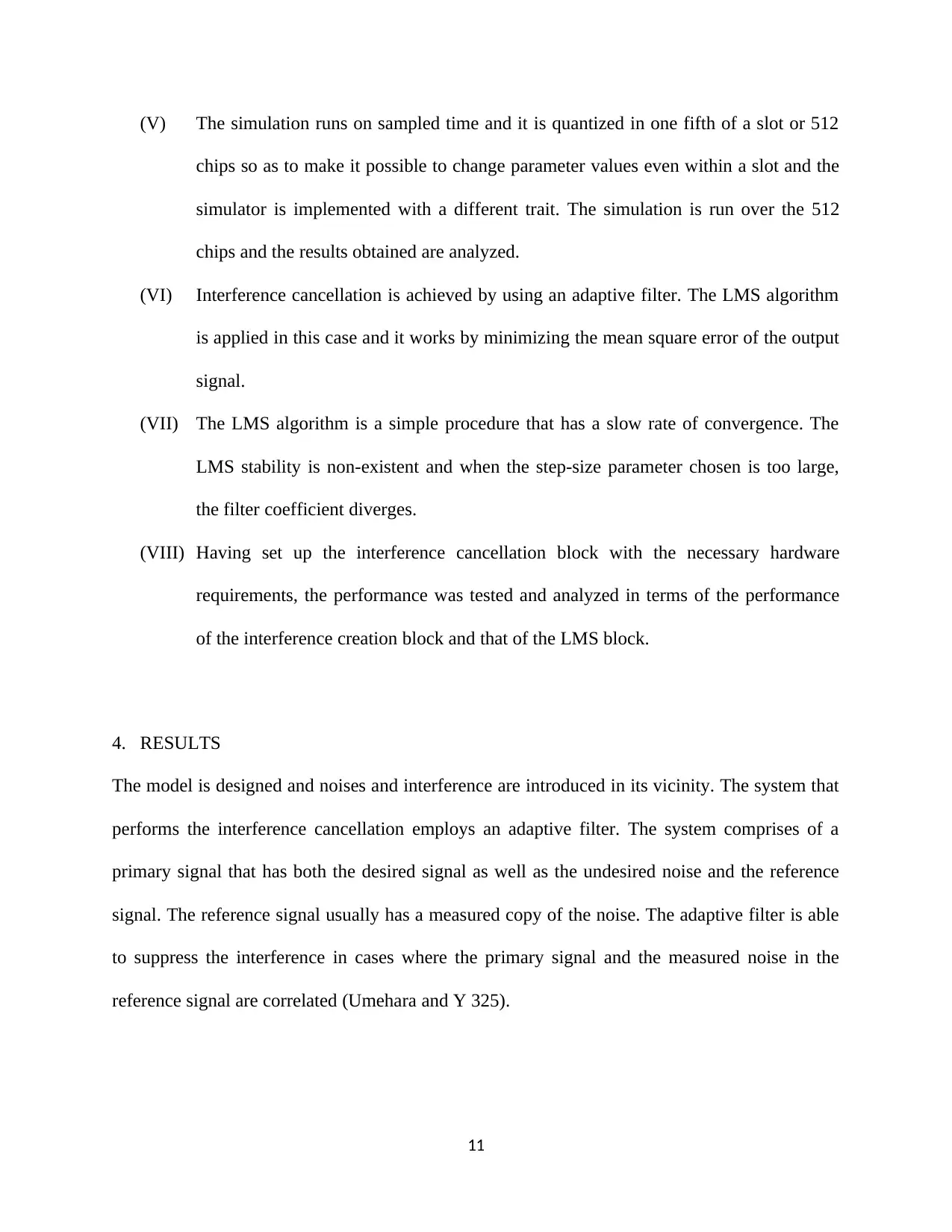
(V) The simulation runs on sampled time and it is quantized in one fifth of a slot or 512
chips so as to make it possible to change parameter values even within a slot and the
simulator is implemented with a different trait. The simulation is run over the 512
chips and the results obtained are analyzed.
(VI) Interference cancellation is achieved by using an adaptive filter. The LMS algorithm
is applied in this case and it works by minimizing the mean square error of the output
signal.
(VII) The LMS algorithm is a simple procedure that has a slow rate of convergence. The
LMS stability is non-existent and when the step-size parameter chosen is too large,
the filter coefficient diverges.
(VIII) Having set up the interference cancellation block with the necessary hardware
requirements, the performance was tested and analyzed in terms of the performance
of the interference creation block and that of the LMS block.
4. RESULTS
The model is designed and noises and interference are introduced in its vicinity. The system that
performs the interference cancellation employs an adaptive filter. The system comprises of a
primary signal that has both the desired signal as well as the undesired noise and the reference
signal. The reference signal usually has a measured copy of the noise. The adaptive filter is able
to suppress the interference in cases where the primary signal and the measured noise in the
reference signal are correlated (Umehara and Y 325).
11
chips so as to make it possible to change parameter values even within a slot and the
simulator is implemented with a different trait. The simulation is run over the 512
chips and the results obtained are analyzed.
(VI) Interference cancellation is achieved by using an adaptive filter. The LMS algorithm
is applied in this case and it works by minimizing the mean square error of the output
signal.
(VII) The LMS algorithm is a simple procedure that has a slow rate of convergence. The
LMS stability is non-existent and when the step-size parameter chosen is too large,
the filter coefficient diverges.
(VIII) Having set up the interference cancellation block with the necessary hardware
requirements, the performance was tested and analyzed in terms of the performance
of the interference creation block and that of the LMS block.
4. RESULTS
The model is designed and noises and interference are introduced in its vicinity. The system that
performs the interference cancellation employs an adaptive filter. The system comprises of a
primary signal that has both the desired signal as well as the undesired noise and the reference
signal. The reference signal usually has a measured copy of the noise. The adaptive filter is able
to suppress the interference in cases where the primary signal and the measured noise in the
reference signal are correlated (Umehara and Y 325).
11
⊘ This is a preview!⊘
Do you want full access?
Subscribe today to unlock all pages.

Trusted by 1+ million students worldwide
1 out of 23
Related Documents
Your All-in-One AI-Powered Toolkit for Academic Success.
+13062052269
info@desklib.com
Available 24*7 on WhatsApp / Email
![[object Object]](/_next/static/media/star-bottom.7253800d.svg)
Unlock your academic potential
Copyright © 2020–2025 A2Z Services. All Rights Reserved. Developed and managed by ZUCOL.





